
CareConnect
From friction to fluidity
Growing engagement with technically challenged caregivers
B2B
SaaS
Mobile
Responsive
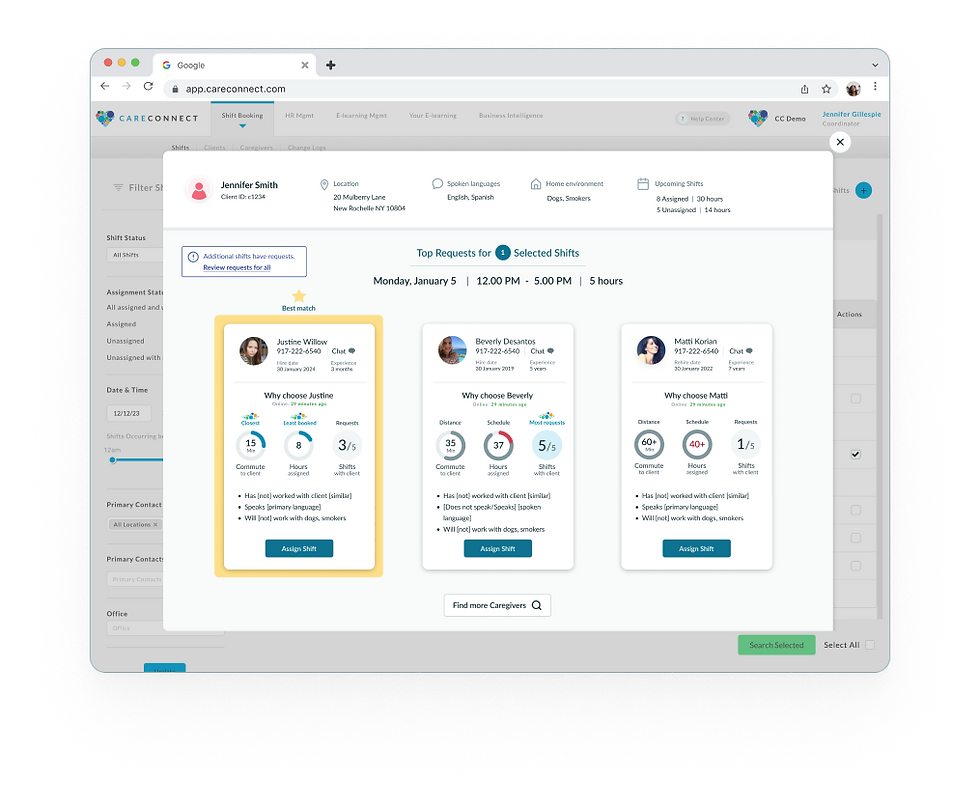


CareConnect is a platform that supports home healthcare providers through a web portal for agencies and a mobile app for caregivers.


TL;DR
Creating a new scheduling workflow to support Caregivers
In a nutshell
Discouraged Caregivers. Frustrated Schedulers. Limited Time + Budget.
CareConnect needed to improve the most critical task - scheduling shifts. Analytics showed the system was underutilized, backend issues were contributing to front -end confusion, and there was a bit of animosity between the two primary audiences - agency schedulers and caregivers. The platform's complexity, stemming from multiple integrations, compounded these issues.
I led user research, UX strategy and end-to-end design, co-designing key features, and guiding the design team through multiple iterations and launch. I facilitated field studies, concept validation, and usability testing with schedulers + caregivers. We moved fast, tested ideas directly with users, and were able to influence the product end-to-end.
Through fast, guerrilla-style research and close collaboration with product, design and engineering, we delivered a new scheduling experience that benefited both the business and users, that was both user friendly and reliable, even with large amounts of data + traffic.
Caregiver engagement increased, operational costs were reduced, and — now offered as a stand-alone offering — this work has created a path for new revenue.
Feature highlights
Moving quickly and collaboratively, we tested ideas directly with users and partnered closely with developers to bring an intuitive experience to life, while optimizing performance.
Key takeaways
Customer engagement exceeded expectations
Successfully lobbied + expanded design system to include interactive quizzes - a template system that cold be used company -wide
Funding for continuation of the work + expansion was secured due to the MVP success
Design
3
Tech
8
Product
2
As the Design Lead I was responsible for:
-
Developing + conducting user research
-
Providing UX Strategy + Design
-
Directing the design team, providing guidance + oversight, + co-designing key features
-
Collaborating with product + tech partners to ideate, develop, validate, and launch
MY TEAM + ROLE
Cross -functional collaboration
RESEARCH + INSIGHTS
Understanding the Scheduler - Caregiver relationship
Activities + observations
To ground the experience in real-world behavior, we conducted lightweight, onsite user research with both agency schedulers and caregivers at multiple agencies. I developed discussion guides, and conducted field studies and one-on-one interviews with Schedulers + Caregivers.
Through these observations and conversations we were able to uncover critical gaps in trust, visibility and communication throughout their scheduling journey — and identify opportunities CareConnect could help.
These insights shaped our design strategy, ensuring solutions addressed both sides of the scheduling experience.
Key insights
Caregivers felt discouraged and overlooked.
Many were new and uncomfortable with technology, relying on frequent phone calls and personal relationships with schedulers to get work
They wanted to work more, but couldn't see or request available shifts in the app.
Schedulers were overwhelmed and didn't trust the system.
They were working under tight deadlines, and reluctant to assign shifts to untested newer caregivers.
With little trust in the system, they would bypass the recommended matches, and default to inviting all caregivers to all shifts.
Teamwork: How I mapped out the experience
Partnering with product, I prioritized first-time caregiver guidance, surfacing meaningful shifts, and nudging schedulers toward most relevant shift requests through intentional friction.
What I did
Collaborated with product + tech team to brainstorm ideas, and understand what would be possible
Identified critical features to support Caregiver journey
Mapped out caregiver -centric flow to foster exploration + discovery
Led design team through concept development + detailed design


Guiding Caregivers: Setting up first-time users for success
What I did
Designed an onboarding flow that:
-
Walked new users through filter options, ensuring most relevant shifts would be displayed
-
Pre-selected options based on shift preferences + previous behavior
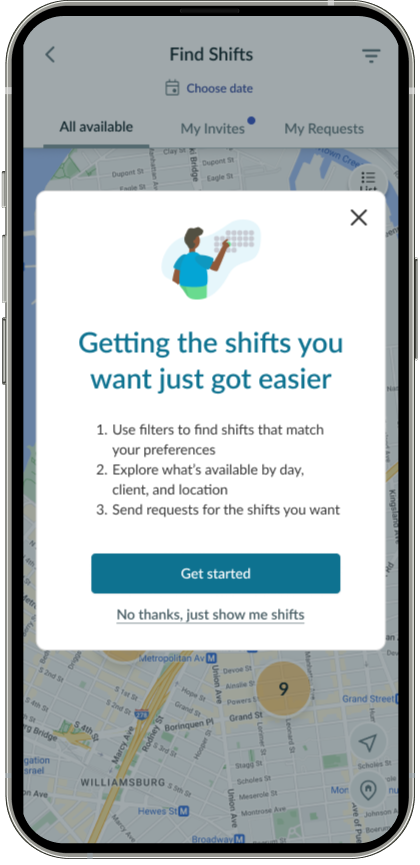
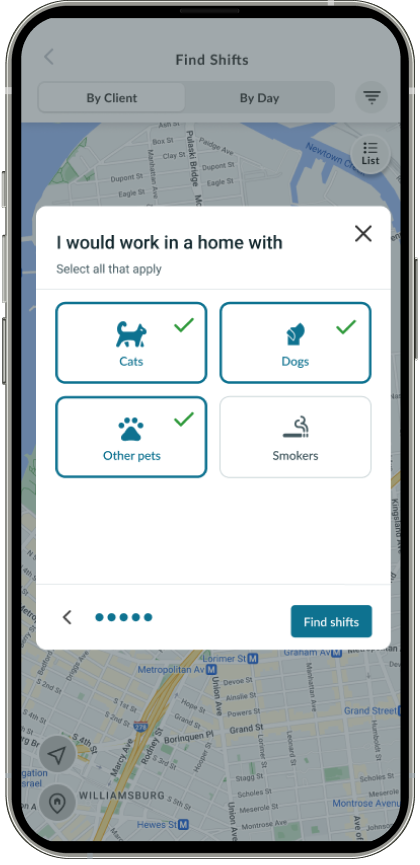
Guiding Caregivers: Supporting meaningful discovery + exploration
What I did
Default view showed relevant shifts by proximity to caregiver
Encouraged client continuity by defaulting to client views, enabling easy requests for all available shifts
Provided simple path to explore by date; for those caregivers looking to build their schedule


Validation with users
What I did
Iteratively tested with users throughout - from early concept validation through usability testing high -fidelity prototypes.
Partnered closely with engineers to tackle complexity + map display rules to optimize both performance and usability.
Conducted onsite roadshows with agency management to build internal agency support.


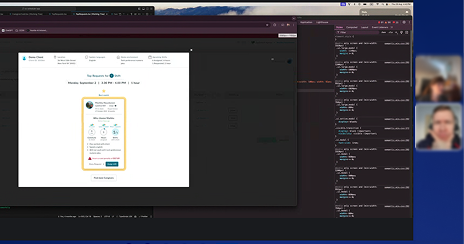
Supporting Caregivers: Applying deliberate friction to nudge Scheduler behavior
What I did
Developed a Top Requests modal, displayed before Schedulers could submit invites for shifts that had relevant requests.
-
Displayed data critical for decisions to build trust in system matches
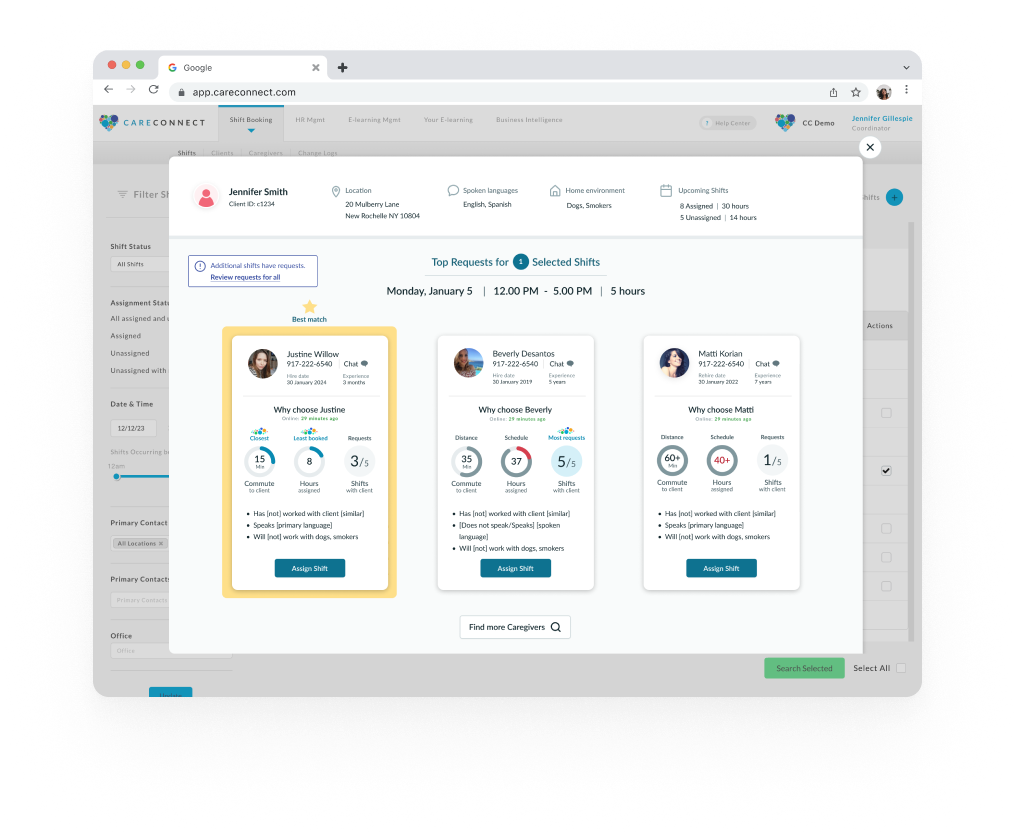
Design + Build + Validate = Launch
Meet them where they are: Designing an approachable + guided Caregiver journey
RESEARCH + INSIGHTS
Understanding the Scheduler - Caregiver relationship
Identified critical breakdowns in trust, visibility, and communication.
-
Developed discussion guides
-
Conducted onsite field studies + one-on-one interviews with Caregivers + Schedulers
-
Identified breakdowns in trust, visibility, and communication.
What I did
Developed discussion guides
Conducted onsite field studies + one-on-one interviews with Caregivers + Schedulers
Identified breakdowns in trust, visibility, and communication.
What I learned: Key insights
Both schedulers + caregivers were stuck in inefficient patterns
-
Caregivers - often new to technology - had no visibility into available shifts or staffing decisions, and frequently called agencies for updates. Many felt discouraged and overlooked, leading to high turnover.
-
Schedulers were overwhelmed, working under tight deadlines, and reluctant to assign shifts to untested newer caregivers. With little trust in system matches, they defaulted to inviting all caregivers to all shifts.
-
Prioritized first-time caregiver guidance, surfacing relevant shifts, and nudging schedulers toward better matching through intentional friction.
-
Iteratively tested lo-fi to hi-fi prototypes with users to refine flows and build trust in the system.
THE CHALLENGE
Frustrated Schedulers. Discouraged Caregivers. Limited time + budget.
How can we provide a scheduling experience that supports technically challenged and eager to work Caregivers?
CareConnect, a platform supporting home healthcare providers, faced challenges with its shift scheduling process.
-
Caregivers wanted to work more, but without visibility into what shifts were available, they were left waiting to first be invited, then assigned. Many felt discouraged and overlooked, leading to high turnover.
-
Agency Schedulers were overwhelmed, working under tight deadlines in chaotic conditions, and reluctant to assign shifts to untested newer caregivers. With little trust in system -generated AI matches, they would often manually invite hundreds of caregivers per shift.
The platform's complexity, stemming from multiple integrations, further compounded these issues.


THE APPROACH
Surfacing the right detail at the right moment — helping Caregivers discover shifts that matter most, and guiding Schedulers to make smarter, more equitable assignments
Key takeaways
Thoughtful human -centric design thinking and cross-functional collaboration can shift deeply ingrained behaviors, deliver operational efficiency, and unlock new business value — even within tightly constrained environments.
User research does not have to be expensive or time consuming to add significant value. Having direct access to users revealed gaps and pain points not visible in data alone, and helped to shape a solution that addressed real needs.
Collaboration built alignment. Trusted working relationships between design, product and engineering, led to development of a platform that was both reliable, user -friendly and met the needs of Caregivers.
Adaptability was essential. We balanced user needs with technical realities, time pressures, and budget constraints, finding creative, pragmatic ways to deliver meaningful impact.














